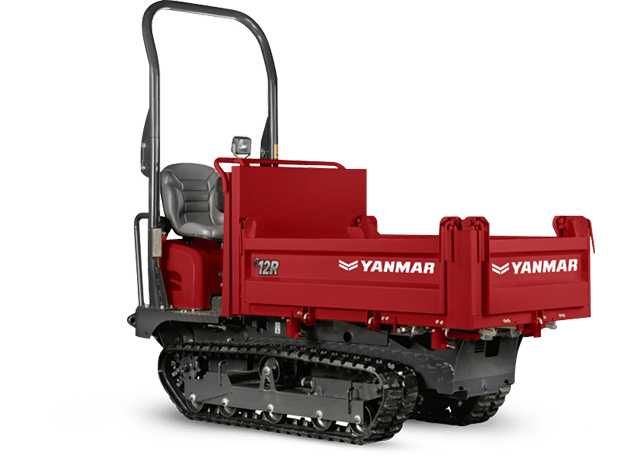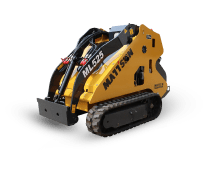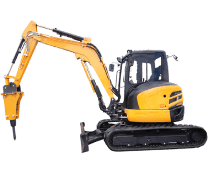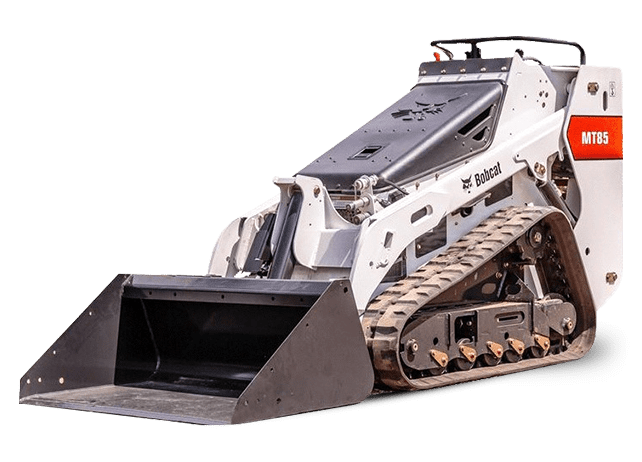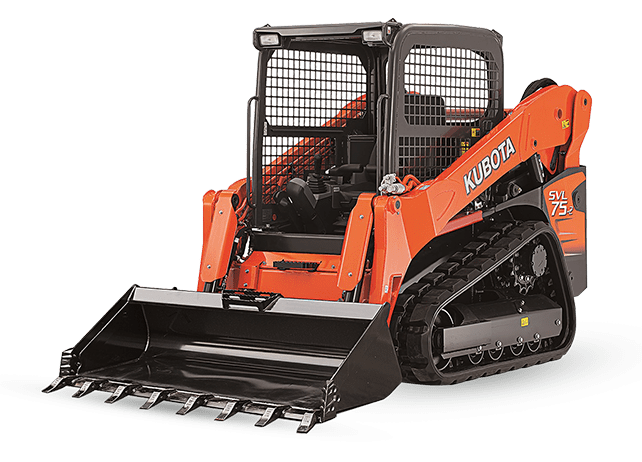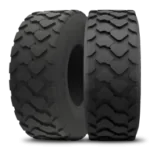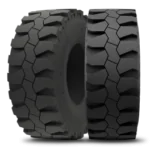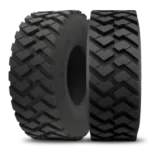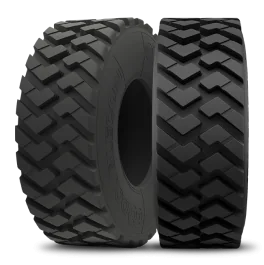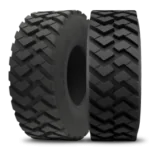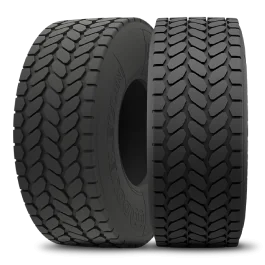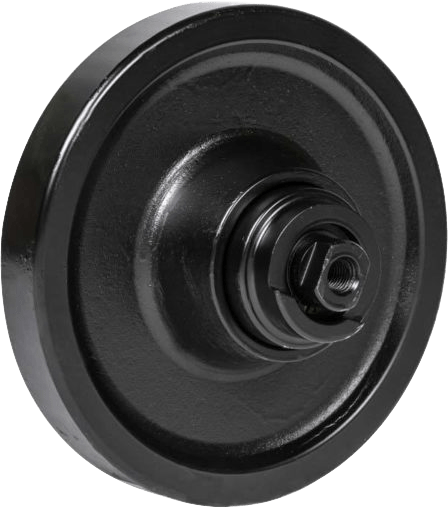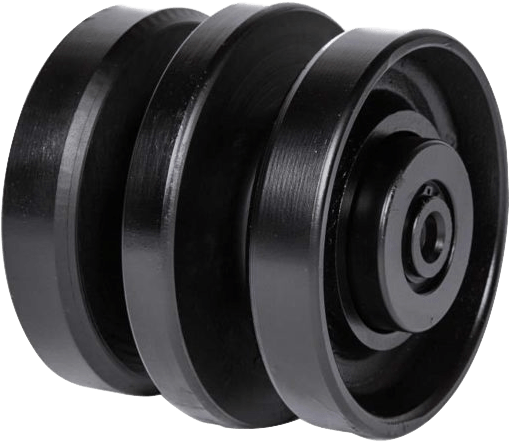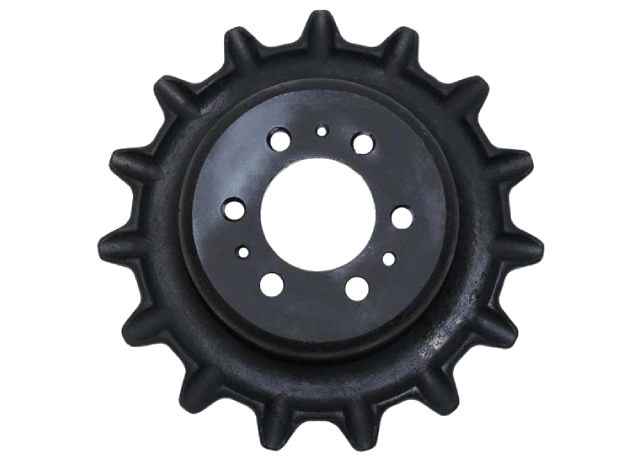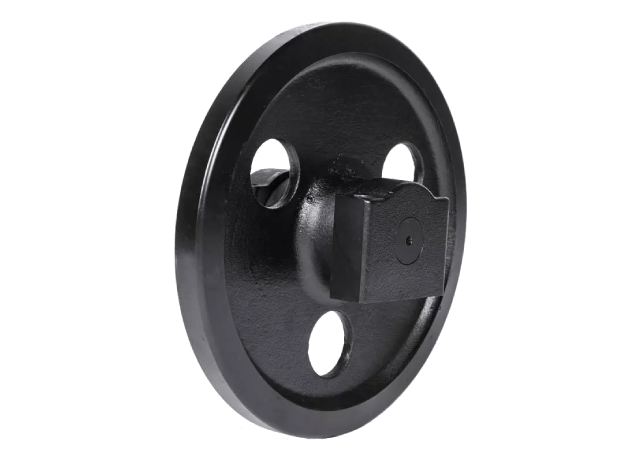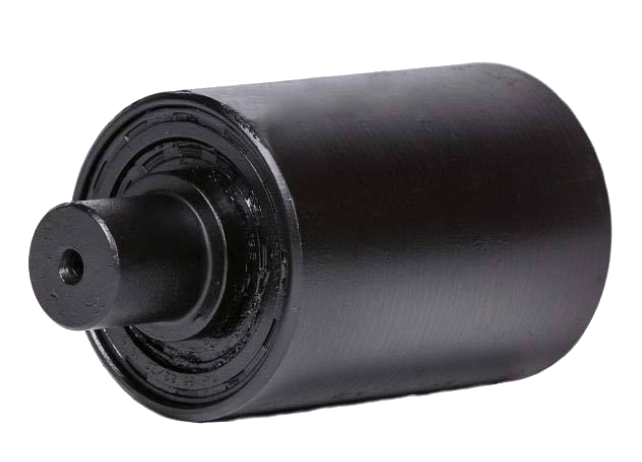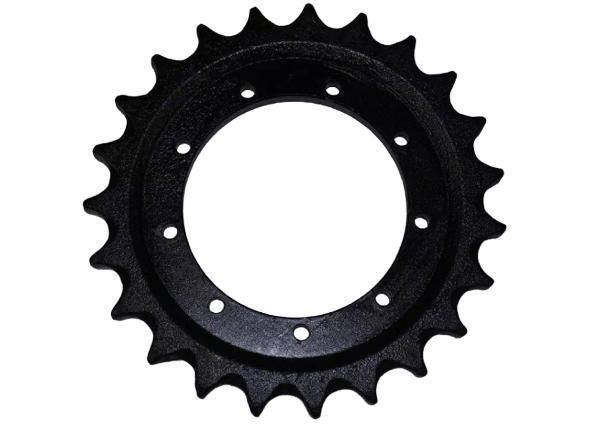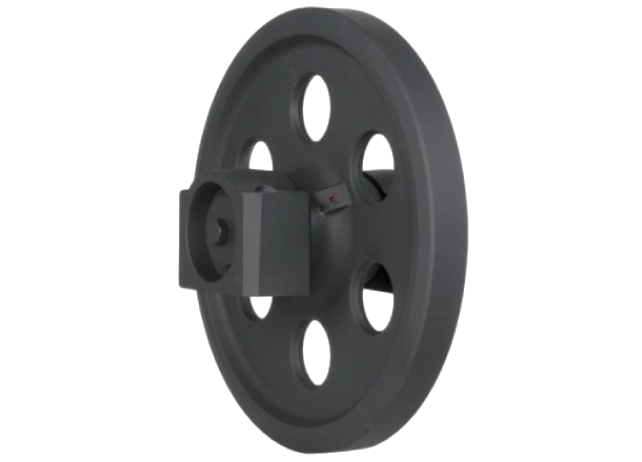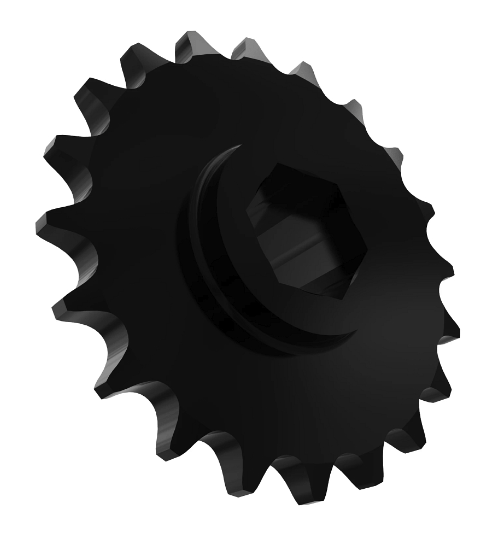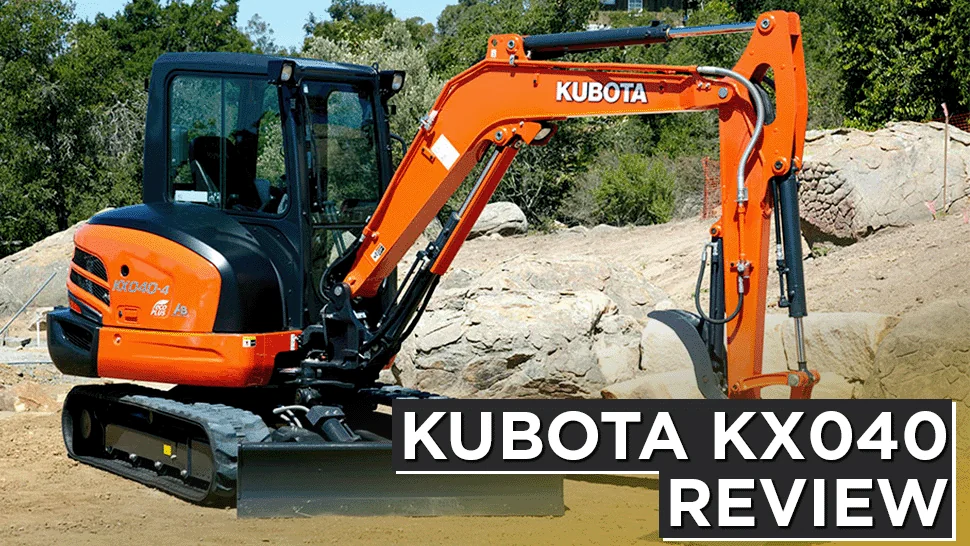Photo source: www.kubotausa.com
The Kubota KX040 replaced the KX121 and, as of 2024, is Kubota’s best-selling mini excavator.
One of the key upgrades in the KX040 is its improved engine, from TIER3 to TIER4. Additionally, it offers a more comfortable and roomy cab design, complete with better heater/AC ducting and vents, ensuring a pleasant and productive work environment.
Before purchasing this 4-ton mini excavator, define your goals at the job site. Otherwise, you’ll end up in the land of “I wish”: I wish it had a bit more power like the KX057 or were smaller like the UL17.
In this unbiased review, we’ll discuss the KX040’s best and not-so-good aspects, compare it with similar machines, and see why some people prefer it over the competition.
Table of Content
The Best Features of the Kubota KX040

Photo source: www.ritchielist.com
The first thing you’ll notice about the KX040 is its simplicity.
The KX040 cab isn’t luxurious. It has basic comfort and good functionality without crazy electronics–after all, it’s a mini excavator.
The switches to control the throttle, AC, economy mode, etc., are on your right-hand side.
The Kubota KX040-4 has hydraulic over hydraulic controls for quick response, letting you “feel” what the machine is doing.

Photo source: www.ritchielist.com
The digital panel is simple. You can cycle through to see RPMs, check maintenance intervals, activate and change the closing speed of the thumb (1 – 1/2 sec cycle time), etc.
Apart from being simple, several things contribute to making the KX040 cab roomy and comfy:
- The cabin floor is completely flat, providing more legroom.
- The rear counterweight design pushes the seat further back than the U series.
- The pedals are foldable for extra legroom. When the pedals are folded, you can use the levers to drive the machine.
- You can adjust the wrist support and the high-back suspension seat (forward and back).
- As with many Kubota construction equipment, the KX040 has an overhead door. You can dig with the door open during summer or talk from the cab with crewmates. There’s also the option to leave the door locked open while working.
- Unlike other Kubota machines, like the SVL75-2, the KX040-4 has less engine noise.
The KX040 engine, cooler, and hydraulic components are super accessible and easy to maintain. You can do pretty much everything by standing or stooping down beside the machine. Mechanically inclined guys will likely maintain this piece of equipment themself.

Photo source: www.ritchielist.com
For your safety, Kubota strongly recommends using a Rollover Protective Structure (ROPS) and seat belt for almost all applications. Nevertheless, there’s a KX040 canopy version.
The Kubota KX040-4 also has three blade model options:
- Regular straight blade.
- Hydraulic angle blade for backfilling or trenching. Instead of repositioning the machine, adjust the blade’s angle to the left or right.
- Six-way blade that moves left, right, up, down, and tilts side to side.
Like the SVL97-2, the KX040 has a closed-center hydraulic system, letting you perform multiple functions simultaneously without sacrificing much performance. It diverts the hydraulics where they need to be instead of prioritizing one function over others.
Regarding attachments, the KX040 quick coupler can be either mechanical or hydraulic, and you can opt for single or double auxiliary lines to run the highly recommended thumb and another attachment.

Photo source: www.orangetractortalks.com/forums
With two aux lines, you can use the thumb and a second attachment at the same time. Choosing one aux line includes a diverter valve to change the oil supply without removing the thumb pipeline when the operator wants to use a hydraulic attachment.
Remember to manipulate the diverter valve on each boom side because every attachment has an in and an out.
The Kubota KX040-4 features a theft protection system: an on/off switch on top of the battery and coded keys—three keys: the start key, a spare, and the red key, which is a programming key only.
Don’t lose the red key, or you’ll have to go to the dealership for a new ECU (Electronic Control Unit), which will be expensive. When buying a used Kubota with an anti-theft key system, be sure to ask for the red key!
The last thing worth highlighting in this section is transportation.
Federally, the Gross Combined Weight Rating (GCWR) of a truck and its trailer can’t exceed 26,000 lb, or you’ll need a Class A commercial driver’s license (CDL). The GCWR is the maximum weight a vehicle can safely carry, including the weight of the vehicle, passengers, cargo, and trailer.

The KX040 is big enough to handle heavy-duty tasks and is legal (it weighs 9,655 lb with steel tracks and cabin) to haul on a 14k trailer behind a 1-ton pickup without a CDL.
Like most of Kubota’s machines, all of the above guarantee that the KX040 holds its resale value as “Gunners,” a well-known member of the Plant Talk website and a seasoned mini excavator owner claims.
The Cons of the KX040

Photo source: www.kubotausa.com
Most criticism of the KX040 comes from operators and owners dissatisfied with the equipment compared to more robust, smaller, or upgraded models. For example, the digital screen, although better than the mini excavator KX121, looks decent compared to the one of the KX057.
Objectively speaking, the KX040 mini excavator does have a few minor flaws, mainly revolving around the cab.
It is perfect for an average person, a 6 ft, 180 lbs dude. However, the cabin won’t be that comfy for bigger guys. Also, the pilot control lever sticks a bit into the opening when entering the cab.
The hood and instrument panel’s coming-down design blocks your view of one side of the blade, and the door latches block the other. You’ll have to open the door if you need to see both sides of the blade while doing fine grading.

Photo source: www.philadelphia.craigslist.org
Why not install a single big glass on the roof instead of three small skylight windows (like the KX057)?
Lastly, in the cab department, there’s the topic of halogen front lights. Halogens aren’t as bright as LEDs and take longer to reach full brightness.
Lumens measure how much light a bulb produces. Halogen lights emit about 16-24 lumens per watt, whereas LED lights emit about 80-100 lumens per watt. Even if you use a less powerful bulb, LEDs will produce a much higher brightness level.
Regarding operation, some operators complain about the lack of a throttle lock and that you must press the AUX button to arm the thumb every time you raise the pilot control lever. It’s part of the learning curve, and after a few hours of operation, you probably won’t even care about it.
Overall, the KX040 is stable. However, a brush hog attachment makes the mini excavator sketchy and tippy, especially when extending the boom on the side (unlike the KX057).
Specifications of the KX040
The KX040 is a simple mid-size mini excavator in terms of electronics, yet it has several smart features to improve performance in the field.
General Features

| Model in (mm) | KX040 with a regular blade | ||||||
|---|---|---|---|---|---|---|---|
| Engine | Model | Kubota D1803-CR-TE4 |
|||||
| Gross Output - HP (kW) / rpm |
40.4 (30.1) / 2,200 | ||||||
| Hydraulic system | Auxiliary hydraulic flow - GPM (l/min) |
AUX 1 | 17.2 (65) | ||||
| AUX 2 | 9.8 (37) | ||||||
| Drive train | Travel speed - mph (km/h) |
Low | 1.8 (2.9) | ||||
| High | 3.1 (5.0) | ||||||
| Tumbler distance - ft. in. (mm) * |
5’ 7.3’’ (1,710) | ||||||
| Ground contact pressure - psi (kPa) |
Rubber tracks |
Canopy | 4.53 (31.2) | ||||
| Cab | 4.68 (32.3) | ||||||
| Steel tracks |
Canopy | 4.61 (31.8) | |||||
| Cab | 4.76 (32.8) | ||||||
| Swing system | Swing speed - rpm | 9.2 | |||||
| Boom swing angle - degrees | Right | 55 | |||||
| Left | 70 | ||||||
| Operating weight (Including operator’s weight @ 175 lbs) - lbs (kg) |
Rubber tracks | Canopy | 9,195 (4,170) | ||||
| Cab | 9,500 (4,310) | ||||||
| Steel tracks | Canopy | 9,350 (4,240) | |||||
| Cab | 9,655 (4,380) | ||||||
| Lifting capacity (with cab, rubber crawler, standard blade, and without a bucket) See “Lift Point Radius and Height Diagram” below |
|||||||
| Lift point height from ground level - ft | Over the front - lbs | Over the side - lbs | |||||
| Lift point radius - ft | Lift point radius - ft | ||||||
| 8 | 12 | 14 | 8 | 12 | 14 | ||
| 6 | 2,720 | 1,910 | 1,750 | 2,720 | 1,600 | 1,270 | |
| 4 | 3,540 | 2,130 | 1,860 | 2,760 | 1,500 | 1,250 | |
| 2 | 4,080 | 2,320 | 1,960 | 2,650 | 1,510 | 1,220 | |
| 0 | 4,250 | 2,430 | 2,010 | 2,600 | 1,480 | 1,210 | |
| Operating dimensions - see "Reach Diagram" below | |||||||
| A | Max. digging height - ft. in. (mm) | 17’ 6’’ (5,335) | |||||
| B | Max. dumping height - ft. in. (mm) | 12’ 9.5’ (3,900) | |||||
| C | Max. digging depth - ft. in. (mm) | 11’ 9.5’’ (3,420) | |||||
| D | Max. vertical digging depth - ft. in. (mm) | 7’ 4.8’’ (2,255) | |||||
| E | Max. digging radius at ground level - ft. in. (mm) | 17’ 9’’ (5,410) | |||||
| F | Max. digging radius - ft. in. (mm) | 18’ 2.1’’ (5,540) | |||||
| G | Min. turning radius - ft. in. (mm) | Without swing | 7’ 1.8’’ (2,180) | ||||
| With swing | 5’ 11.1’’ (1,805) | ||||||
| H | Min. tail turning radius - ft. in. (mm) | 4’ 3.2’’ (1,300) | |||||
Fortis HD supplies top-tier rubber tracks for Kubota mini excavators, designed to keep your equipment running with minimal interruption. Our tracks are precisely engineered to fit Kubota models, like the KX040, ensuring reliable performance and longevity.


* The tumbler distance is the measurement between the centers of the front idler and the sprocket on the tracks. It affects the machine’s stability and operation.
Industry Leading Technology
Some of the tech features on the KX040 mini excavator aim for safety, efficiency, and durability. Let’s briefly break them down in that order.

⓵ Pilot Control Lock Lever
Ⓐ Unlock
Ⓑ Locked
Remember the pilot control lever we mentioned earlier? It serves two safety purposes to prevent accidents from unexpected machine movements:
- While in the locked (up) position, it will let you start the machine but shut off hydraulic functions.
- While in the unlocked (down) position, it will let you use hydraulics, but if the machine shuts down or you turn it off, you won’t be able to start it again until you raise it.
Like the SVL75-2, the KX040 has an auto downshift function that automatically downshifts for maximum torque and traction when turning and shifts back to high speed when traveling straight for safety and maximum productivity.
Several features on the KX040, such as the Common Rail System (CRS), the auto idling system, and the ECO mode (ECO PLUS), work toward reducing operating costs.
The CRS is a modern technology that controls the injection timing and quantity to enhance combustion efficiency, resulting in more power and torque from the engine.
As its name suggests, the auto-idling system sets the engine RPM to idle when the controls are neutral for more than four seconds. When you move a control lever, the engine RPM immediately returns.
On the other hand, the ECO mode reduces the engine’s RPM even when the machine is under load, meaning that it tries to achieve the desired performance with lower fuel use.
The ECO mode is handy during tasks that don’t require maximum power, allowing operators to save diesel without significantly sacrificing productivity.

Photo source:www.kubotausa.com
Kubota claims its ECO mode can generate fuel savings of up to 9% over its standard mode, which in turn saves 12% more fuel than the prior model (KX121-3). Thus, approximately 20% fuel savings over the KX121-3 that some owners state in their YouTube videos.
Like most mini excavators in the market, the KX040 also includes a blade float mode, which allows the blade to automatically float above the surface and follow the ground’s contour without digging in for a smooth back grading.
A brief parenthesis about the float mode: don’t start back dragging with the float mode on. Instead, touch the ground with the blade and back-drag manually and slowly until you build up some material with the blade. Then, start the float mode and angle the blade to shoot the material to where you will make another pass.
When ready to come out of float, slowly raise the blade to let the material run out. That way, you’ll get a pretty-looking pass.
Finally, a valve called the third-line hydraulic return system contributes to durability and efficiency.

Photo source: https://kubota.ca/products/KXB-Series
It’s suitable for one-way hydraulic attachments like breakers or brush cutters. Since those attachments require oil to flow continuously in one direction, the valve allows oil to flow directly back to the tank without running through the control valves. Thus, less oil contamination, reduced back pressure (due to fewer changes in flow direction), and greater oil flow efficiency.
Because the engine is above 26 HP, it needs a regeneration system to burn soot out of the DPF (diesel particulate filter). You cannot turn on the aux hydraulics when it goes into regen mode, like when using the thumb. There’s an inhibit button to cancel regeneration.
Kubota advises not to hit the inhibit switch too often, or you’ll have to go to the dealership for a forced DPF regeneration.
Last, a simple and helpful detail: an audible indicator to prevent the fuel tank from overflowing when filling up. It’ll beep faster as you reach the top. Below, we share a picture from the KX040 owner’s manual showing the beeping frequency according to the fuel level.

How Does the KX040 Stand Against Similar Mini Excavators?

Photo sources: www.kubota.ca | www.bobcat.com | www.takeuchiglobal.com
| KX040 COMPARED AGAINST THE COMPETITION | |||||
|---|---|---|---|---|---|
| Model | KX040 | Takeuchi TB240 | Bobcat E42 | Cat 304E CR | Yanmar SV 40 |
| PERFORMANCE | |||||
| Tail Swing Design | Conventional | Conventional | Conventional | Zero tail | Short |
| Operating Weight - lb (kg) | 9,195 (4,170) | 8,570 (3,890) | 10,425 (4,729) | 8,721 (3,956) | 9,206 (4,176) |
| Max Digging Depth | 11' 2.7'' (3,420 mm) |
11' 4.4'' (3,465 mm) |
11' 4.8'' (3,475 mm) |
11' 3'' (3,429 mm) |
11' 4'' (3,440 mm) |
| Max Dump Height | 12' 9.5'' (3,900 mm) |
12' 6.7'' (3,828 mm) |
12' 10.9'' (3,932 mm) |
12' 1'' (3,683 mm) |
11' 11'' (3,641 mm) |
| Max Reach | 18' 2.1'' (5,540 mm) |
18' 2.3'' (5,545 mm) |
18' 2.4'' (5,547 mm) |
18' 4'' (5,588 mm) |
18' 0'' (5,500 mm) |
| Max Bucket Digging Force - lb (kg) | 9,535 (4,325) | 9,959 (4,517) | 9,601 (4,355) | 8,498 (3,855) | 7,209 (3,270) |
| Max Arm Digging Force - lb (kg) | 4,112 (1,865) | 4,110 (1,864) | 5,803 (2,632) | 4,384 (1,989) | 4,211 (1,910) |
| ENGINE | |||||
| Horsepower - hp (kW) | 40.4 (30.1) | 35.8 (26.7) | 42.6 (31.8) | 41.8 (31.2) | 39.0 (29.1) |
| UNDERCARRIAGE | |||||
| Ground Pressure - psi (kPa) | 4.5 (31.0) | 4.4 (30.2) | 4.3 (29.6) | 4.1 (28.3) | 4.25 (29.3) |
| Travel Speed Low Range - mph (km/h) |
1.8 (2.9) | 1.8 (2.9) | 1.6 (2.6) | 2.1 (3.4) | 1.5 (2.4) |
| Travel Speed High Range - mph (km/h) |
3.1 (5.0) | 3.3 (5.3) | 3.3 (5.3) | 3.2 (5.1) | 2.9 (4.6) |
| HYDRAULIC SYSTEM | |||||
| Auxiliary Hydraulic Flow - gpm (L/m) |
17.2 / 9.8 (65 / 37) | 17.1 (64.9) | 20 (75.7) | 17.2 (65) | 19.1 (72.2) |
| DIMENSIONS | |||||
| Width | 5' 7'' (1,700 mm) |
5' 8.5'' (1,740 mm) |
6' .8'' (1,849 mm) |
6' 5'' (1,950 mm) |
5' 8'' (1,740 mm) |
| Heigh | 8' 2'' (2,485 mm) |
8' 2.6'' (2,505 mm) |
8' 3'' (2,517 mm) |
8' 2'' (2,489 mm) |
8' 2'' (2,540 mm) |
| Length (Transport) | 16' 8'' (5,085 mm) |
16' 8.2'' (5,085 mm) |
16' 9.7'' (5,123 mm) |
16' 2'' (4,928 mm) |
15' 9.5'' (4,810 mm) |
In addition to the technical specs listed above, the cab, boom, and undercarriage are worth comparing.
The Kubota KX040 and Takeuchi TB240 feature a certified ROPS and OPG (top guard, level I) canopy and cab. The Yanmar SV40’s cab/canopy is ROPS and FOPS, the Bobcat 42 has ROPS but not OPG, while the Cat 304E CR is OPG but not ROPS. Here’s the purpose of each protection system:
- Roll-Over Protective Structure (ROPS) is a system of strengthened components that protects the operator in case of a rollover.
- OPG top guard (Operator Protective Guard) and Falling Object Protective Structure protect operators from falling objects. However, their tests and certifications apply to different standards. Here’s a brief explanation of their differences:
- Falling Object Protective Structures (FOPS)—ISO 3449:2005: This standard deals with falling objects and typically involves drop tests. It includes two levels of protection, each corresponding to different sizes of objects and different heights from which the test weights are dropped.
- Operator Protective Structures (OPS)—ISO 10262:1998: This standard focuses on dynamic objects such as thrown rocks or debris and involves dynamic impact tests with projectiles. It specifies four levels of protection, with each level providing increasing degrees of protection against higher-energy impacts.

Photo source: www.bobcat.com
The KX040, SV40, and TB240 display screens are decent. The Cat 304E CR is bigger, looks better, and offers nice functions like changing the control pattern. Still, we’ll give the Bobcat E42 the 1st place with its 7-inch touchscreen.
Speaking of changing patterns, while the Kubota KX040, Bobcat E42, and Cat 304E CR let you change them from within the cab, you’ll have to open compartments on the Takeuchi TB240 and the Yanmar SV40 to get to the pattern selection lever.

Photo source: www.ritchielist.com
The Kubota KX040 and Yanmar SV40 have large enough, foldable foot pedals. While the Bobcat E42 also has foldable pedals, they are shorter and too close to the foot guard. The pedals on the Takeuchi TB240 and the Cat 304E CR don’t fold, which takes up considerable floor space.
Every brand has similar booms, but the Bobcat E42 has a unique feature: an optional extendable arm. At full extension, it delivers up to 30 inches of reach (compared to standard arms), so you can get farther with less repositioning.
The KX040 and SV40 feature double-flanged track rollers, which provide more track stability than the 304E CR and the E42, which have single-flanged rollers. On the other hand, the TB240 has triple-flanged rollers for the highest level of track stability and prevention against track derailment.
Whether your mini excavator has single, double, or triple-flanged track rollers, we have them all at Fortis.
Visit our undercarriage parts section to buy OEM-endorsed aftermarket Kubota mini excavator rollers engineered to surpass your expectations.
Conclusion
Let’s recap some of the key aspects discussed that make the KX040 one of the most popular mini excavators in the US, backed by testimonials of several owners from forum sites like Heavy Equipment Forums, Tractor by Net, and Orange Tractor Talks.
- It’s a reliable and durable machine with a comfortable cab. The AC system is better than the previous model, and unlike other Kubota equipment, the cabin is quiet.
- Although it’s a powerful excavator, its weight is less than 10,000 lb, so you won’t require a commercial driver’s license to haul it around.
- Whether you’re planning to upgrade from the KX121-3 to the KX040 or from the KX0404 to the KX057, Kubota’s reliability and durability help these pieces of equipment to hold their resale value very well.
Kubota’s simplicity, durability, and reliability extend to other equipment, like the compact track loaders SVL75-2 and SVL97-2. Check out our reviews to learn why, along with the KX040, they are among the most popular construction equipment in the US:
Not a fan of Kubota? Then check our John Deere 35G mini excavator review.

